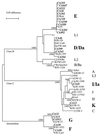Molecular epidemiology of genital Chlamydia trachomatis infection in high-risk women in Senegal, West Africa
- PMID: 10618077
- PMCID: PMC86040
- DOI: 10.1128/JCM.38.1.138-145.2000
Molecular epidemiology of genital Chlamydia trachomatis infection in high-risk women in Senegal, West Africa
Abstract
The prevalence and heterogeneity of Chlamydia trachomatis infections in a cohort of female sex workers in Dakar (Senegal) were determined by using endocervical-swab-based PCR DNA amplification assays. The overall prevalence of cervical chlamydial infection was 28.5% (206 of 722), and most of these infections were asymptomatic. An increased number of sexual partners was significantly associated with infection (adjusted odds ratio [AOR] = 1.37; 95% confidence interval [CI] = 1.06 to 1.77), while the presence of a yeast infection was negatively associated with chlamydial infection (AOR = 0.28; 95% CI = 0.10 to 0.83). Six different C. trachomatis genotypes were identified based on phylogenetic analysis of the omp1 gene sequences. Interestingly, genotype E predominated (47.6%) and was not associated with visible signs of cervical inflammation compared to non-E genotypes (P < 0.05). Overall, the high rate of asymptomatic C. trachomatis infection by genotype E may suggest genotype-specific properties that confer a transmission advantage in this high risk population.
Figures

Similar articles
-
Typing of Chlamydia trachomatis strains from urine samples by amplification and sequencing the major outer membrane protein gene (omp1).Sex Transm Infect. 2001 Dec;77(6):419-22. doi: 10.1136/sti.77.6.419. Sex Transm Infect. 2001. PMID: 11714939 Free PMC article.
-
[DNA sequence polymorphism of Chlamydia trachomatis omp1 gene].Wei Sheng Wu Xue Bao. 2006 Apr;46(2):214-8. Wei Sheng Wu Xue Bao. 2006. PMID: 16736579 Chinese.
-
Genital Chlamydia trachomatis (serotypes D-K) infection in Jamaican commercial street sex workers.Genitourin Med. 1997 Oct;73(5):362-4. doi: 10.1136/sti.73.5.362. Genitourin Med. 1997. PMID: 9534744 Free PMC article.
-
Epidemiology of female genital Chlamydia trachomatis infections.Best Pract Res Clin Obstet Gynaecol. 2002 Dec;16(6):775-87. doi: 10.1053/beog.2002.0325. Best Pract Res Clin Obstet Gynaecol. 2002. PMID: 12473281 Review.
-
Molecular epidemiology and genotyping of Chlamydia trachomatis infection in a cohort of young asymptomatic sexually active women (18-25 years) in Milan, Italy.J Prev Med Hyg. 2016 Sep;57(3):E128-E134. J Prev Med Hyg. 2016. PMID: 27980376 Free PMC article. Review.
Cited by
-
Evolutionary dynamics of ompA, the gene encoding the Chlamydia trachomatis key antigen.J Bacteriol. 2009 Dec;191(23):7182-92. doi: 10.1128/JB.00895-09. Epub 2009 Sep 25. J Bacteriol. 2009. PMID: 19783629 Free PMC article.
-
Evolution of virulence.Infect Dis Clin North Am. 2004 Mar;18(1):1-15. doi: 10.1016/S0891-5520(03)00099-0. Infect Dis Clin North Am. 2004. PMID: 15081500 Free PMC article. Review.
-
Study of the prevalence and association of ocular chlamydial conjunctivitis in women with genital infection by Chlamydia trachomatis, Mycoplasma genitalium and Candida albicans attending outpatient clinic.Int J Ophthalmol. 2016 Aug 18;9(8):1176-86. doi: 10.18240/ijo.2016.08.15. eCollection 2016. Int J Ophthalmol. 2016. PMID: 27588273 Free PMC article.
-
Chlamydia trachomatis infections in Greece: first prevalence study using nucleic acid amplification tests.Eur J Clin Microbiol Infect Dis. 2005 Mar;24(3):207-13. doi: 10.1007/s10096-005-1296-8. Eur J Clin Microbiol Infect Dis. 2005. PMID: 15776253
-
Characterization of ompA genotypes by sequence analysis of DNA from all detected cases of Chlamydia trachomatis infections during 1 year of contact tracing in a Swedish County.J Clin Microbiol. 2004 Apr;42(4):1641-7. doi: 10.1128/JCM.42.4.1641-1647.2004. J Clin Microbiol. 2004. PMID: 15071019 Free PMC article.
References
-
- Batteiger B E, Lennington W, Newhall W J, Katz B P, Morrison H T, Jones R B. Correlation of infecting serovar and local inflammation in genital chlamydial infections. J Infect Dis. 1989;160:332–336. - PubMed
-
- Brunham R C, Kimani J, Bwayo J, Maitha G, Maclean I, Yang C L, Shen C X, Roman S, Nagelkerke N J D, Cheang M, Plummer F A. The epidemiology of chlamydia trachomatis within a sexually transmitted diseases core group. J Infect Dis. 1996;173:950–956. - PubMed
Publication types
MeSH terms
Substances
Grants and funding
LinkOut - more resources
Full Text Sources
Medical

